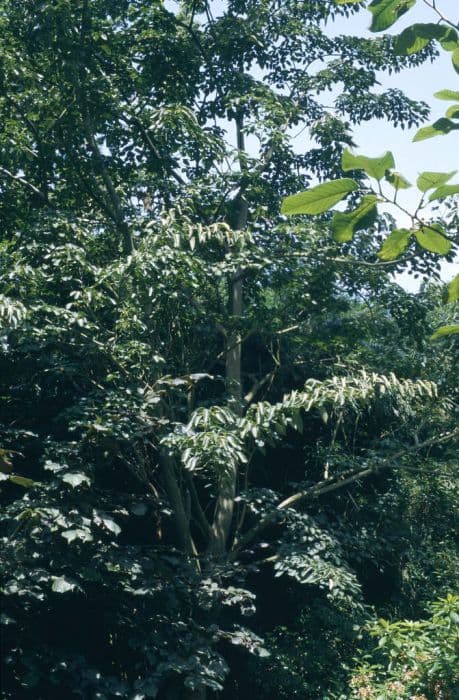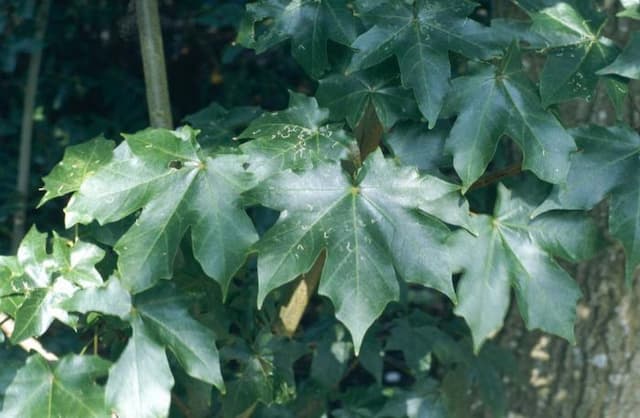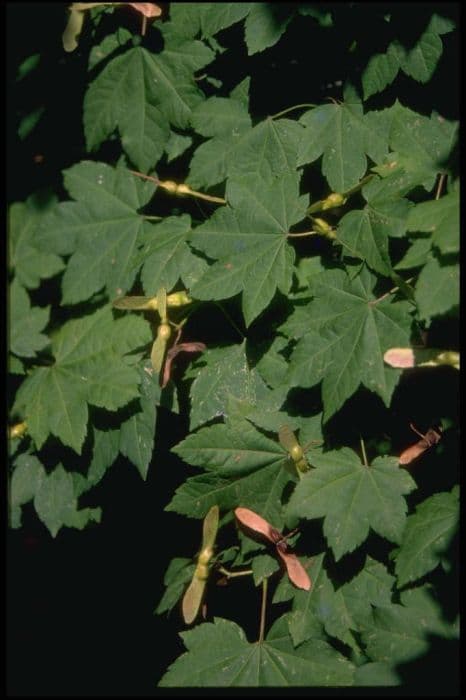Sycamore Maple Acer pseudoplatanus 'Prinz Handjéry'

ABOUT
The Acer pseudoplatanus 'Prinz Handjéry', commonly known as the Sycamore Maple 'Prinz Handjéry', is known for its striking appearance. This cultivar showcases an impressive display of foliage, with leaves that have a unique, deep green color. Each leaf is intricately shaped with five distinct lobes, and the margins are finely toothed, lending a lush and somewhat serrated texture to the overall canopy. What sets the 'Prinz Handjéry' apart are its variegated leaves, which are splashed with cream and pink shades, especially during the spring. As the leaves mature, the pink hues tend to fade, but the cream variegation remains, offering a visual contrast against the deeper green. As seasons change, the foliage undergoes a remarkable transition. During autumn, the green leaves turn to a spectacle of golds and yellows, adding a warm, vibrant touch to the landscape before they eventually fall. The Sycamore Maple 'Prinz Handjéry' is also adorned with flowers in spring. The blooms are subtle and form pendulous clusters, typically yellow-green in color, which dangle beneath the foliage. Following the flowers, winged seed pods, known as samaras, appear. These helicopter-like seeds are a characteristic of maples, starting off green and becoming brown as they mature, twirling to the ground when they are released. The bark of this Sycamore Maple is another distinctive feature. It is smooth and gray when young, becoming more rugged and furrowed with age, providing a range of textures to the plant throughout its life. The combination of colorful foliage, attractive bark, and decorative seeds make the Sycamore Maple 'Prinz Handjéry' a sought-after variety for those looking to add a splash of color and interest to their garden setting.
About this plant
 Names
NamesFamily
Sapindaceae
Synonyms
Sycamore Maple, Prinz Handjéry Sycamore, Variegated Sycamore
Common names
Acer pseudoplatanus 'Prinz Handjery'
 Toxicity
ToxicityTo humans
The plant commonly known as Sycamore Maple is generally not considered highly toxic to humans. However, some people may be sensitive to certain components in the sap which can cause skin irritation or dermatitis upon contact. Ingestion of this tree's parts, particularly in significant quantities, is uncommon but could potentially cause gastrointestinal upset or more severe symptoms in rare cases.
To pets
The Sycamore Maple is known to be toxic to horses, and potentially other pets, with the greatest risk presenting in the ingestion of seeds. Horses can suffer from a condition known as atypical myopathy, which is a muscle disease that can result from eating the seeds of this tree and can be potentially fatal. Symptoms in horses include muscle weakness, stiffness, difficulty standing, and in severe cases, collapse and sudden death. Pets should be kept away from the seeds of the Sycamore Maple to prevent poisoning.
 Characteristics
CharacteristicsLife cycle
Perennials
Foliage type
Deciduous
Color of leaves
Green
Flower color
Yellow-green
Height
35 feet (10.67 meters
Spread
30 feet (9.14 meters
Plant type
Tree
Hardiness zones
5
Native area
Europe
Benefits
 General Benefits
General Benefits- Ornamental Value: Acer pseudoplatanus 'Prinz Handjéry', commonly known as Sycamore maple, has attractive foliage and form which enhances landscape aesthetics.
- Seasonal Interest: This cultivar exhibits colorful foliage changes throughout the seasons, adding visual interest to gardens and parks.
- Shade Provision: The dense canopy of Sycamore maple can provide ample shade, making it suitable for parks and large gardens.
- Habitat for Wildlife: The tree can offer habitat and food for birds and other wildlife, fostering biodiversity.
- Soil Erosion Control: Due to its robust root system, the Sycamore maple can help stabilize soil and prevent erosion.
- Longevity: Being a long-lived species, it contributes to the long-term stability and structure of green spaces.
- Drought Tolerance: Once established, it can withstand periods of drought, making it a resilient choice for varying climatic conditions.
- Low Maintenance: Sycamore maple typically requires minimal maintenance once established, which can be practical for urban and public spaces.
- Adaptability: It is adaptable to a range of soil types and urban conditions, including pollution and restricted growing spaces.
- Cultural Significance: In some regions, the Sycamore maple holds symbolic or historical significance which can be celebrated through its planting.
 Medical Properties
Medical PropertiesThis plant is not used for medical purposes.
 Air-purifying Qualities
Air-purifying QualitiesThis plant is not specifically known for air purifying qualities.
 Other Uses
Other Uses- The wood of Acer pseudoplatanus, or the sycamore maple, can be used in the construction of musical instruments such as violins and guitars for its resonant qualities.
- Its hard and durable timber is ideal for making sturdy kitchen utensils like cutting boards and rolling pins.
- The sycamore maple's large leaves can be used as a natural canvas for botanical art and leaf painting activities.
- The tree's dense canopy provides shelter and nesting sites for birds, supporting biodiversity in urban and rural settings.
- Young stems and branches can be harvested and used in wickerwork and basketry.
- The sap of the sycamore maple can be tapped and reduced to a syrup, similar to how maple syrup is produced, though it is less common and more labor-intensive to process.
- Its durable timber is also used in the manufacturing of sports equipment, such as the backs of archery bows, due to its flexibility and strength.
- The big, flat seeds, known as samaras, can be used in educational settings to explain wind dispersal and other botanical concepts to students.
- In landscape design, the sycamore maple's striking variegated leaves can be used to create vibrant contrasts within ornamental gardens.
- The fallen leaves of the sycamore maple can be collected and composted, contributing to a nutrient-rich soil amendment for gardeners.
Interesting Facts
 Feng Shui
Feng ShuiThe Sycamore Maple is not used in Feng Shui practice.
 Zodiac Sign Compitability
Zodiac Sign CompitabilityThe Sycamore Maple is not used in astrology practice.
 Plant Symbolism
Plant Symbolism- Strength and Endurance: Sycamore trees, like the Acer pseudoplatanus 'Prinz Handjéry', often symbolize strength and endurance due to their hardy nature and long lifespan.
- Protection: The broad leaves of the sycamore provide extensive shade, which in symbolism can translate to protection and shelter provided from external dangers.
- Diversity and Adaptability: With its adaptability to different environments, the sycamore tree can represent the ability to thrive in various conditions and the positive embrace of diversity.
- Resilience: Sycamore trees can grow in challenging conditions and recover well from damage, making them symbols of resilience in the face of adversity.
- Eternal Life: Some cultures associate the sycamore tree with eternity and the spiritual world, partly because of its longevity and its role in various mythologies.
- Regeneration: Sycamores have remarkable regenerative properties, symbolizing renewal, regeneration, and the continuous cycle of life.
 Water
WaterThe Sycamore Maple should be watered deeply and thoroughly, allowing the top inch of soil to dry out between waterings. In the growing season (spring and summer), this might mean watering once or twice a week, but this frequency should be reduced in the fall and further in winter. Mature trees are quite drought-tolerant and may only need supplemental watering during extended dry spells. Younger trees, on the other hand, require consistent moisture. Depending on the size of the tree and the weather conditions, you might use 10-15 gallons of water every two weeks during the active growth phase.
 Light
LightSycamore Maples prefer a location where they receive full sun to partial shade. They can tolerate a bit of shade, but too much can lead to reduced vigor and leaf density. The best spot for this tree would be an area that gets at least four to six hours of direct sunlight daily, ensuring ample light for healthy growth without the intense heat that might come with all-day direct sun in warmer climates.
 Temperature
TemperatureSycamore Maples are hardy and can withstand a wide range of temperatures. They can usually tolerate temperatures as low as -20°F and as high as 90°F, making them quite resilient in varying climate conditions. The ideal temperature range for these trees is between 60°F and 75°F. However, it's important to protect young saplings from extreme cold in their first few years.
 Pruning
PruningPrune the Sycamore Maple to remove dead or damaged branches and to maintain its shape, ideally during dormancy in late winter or early spring before the sap starts to flow. Pruning can also help to improve air circulation and light penetration. Young trees may need more formative pruning to establish a strong structure, while mature trees typically require less frequent pruning unless there are safety concerns or to remove diseased wood.
 Cleaning
CleaningAs needed
 Soil
SoilThe Sycamore Maple 'Prinz Handjery' requires well-drained, fertile soil with a pH range of 5.5 to 7.5. A mix of loam, peat, and sand in equal parts provides an ideal structure and nutrient balance. Regular addition of organic matter will help maintain soil vitality.
 Repotting
RepottingSycamore Maples, including 'Prinz Handjery', generally do not need frequent repotting and are usually repotted every 3 to 5 years. Younger trees may require more frequent repotting as they grow faster than mature ones.
 Humidity & Misting
Humidity & MistingSycamore Maple 'Prinz Handjery' can tolerate a wide range of humidity levels but prefers a moderate humidity. Outdoor conditions typically provide sufficient humidity for this hardy species.
 Suitable locations
Suitable locationsIndoor
Bright indirect light, cool temps; avoid dry heat sources.
Outdoor
Full sun to partial shade, sheltered from strong winds.
Hardiness zone
4-7 USDA
 Life cycle
Life cycleThe life of the Sycamore Maple 'Prinz Handjéry' begins with the germination of its winged seeds, which typically occurs in spring as temperatures rise and consistent moisture is present. Once germinated, the seedling undergoes vegetative growth, developing a root system and foliage as it becomes a sapling. As the sapling matures, it experiences a period of vigorous growth where the tree rapidly increases in height and girth, and develops a distinctive canopy. After reaching maturity, which can take several years, the Sycamore Maple 'Prinz Handjéry' enters its reproductive phase, producing clusters of small, yellow-green flowers in spring, which are followed by the distinctive winged seeds known as samaras. These seeds are then dispersed by wind, allowing the cycle to continue when they find suitable conditions for germination. Throughout its life, which can span over a hundred years, the tree undergoes periodic cycles of growth, flowering, and seed production, with older trees eventually experiencing senescence and decline.
 Propogation
PropogationPropogation time
Spring-Early Summer
The most popular method of propagating the Sycamore Maple 'Prinz Handjery' is through seed collection and sowing. Ideally, propagation by seed occurs in the fall shortly after the seeds mature. To propagate, collect the winged seeds, known as samaras, and sow them in a cold frame as soon as they are ripe. The cold frame simulates the natural stratification process, which the seeds require to break dormancy. It's crucial to maintain consistent moisture during germination without causing the seeds to become waterlogged. Once the seedlings have developed their first true leaves and have grown strong enough, they can be potted on or planted out into their final position. Patience is key, as it may take several years for the seedlings to grow into mature, flowering trees.









